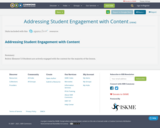
Rubric Element 1.5
Students are actively engaged with the content for the majority of the lesson.
- Subject:
- Education
- Material Type:
- Primary Source
- Date Added:
- 03/23/2018

Rubric Element 1.5
Students are actively engaged with the content for the majority of the lesson.
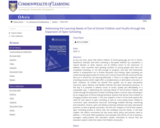
At any one time, about 300 million children of school going age are not in school. Experience indicates that when schooling is disrupted, whether by a pandemic, a natural disaster or other reasons, not all children return to the classroom. In addition, most countries have growing numbers of young people who have not completed schooling, or not well enough to progress, and who find themselves neither in employment nor in further education and training.
Open schooling can create learning opportunities for those not in school, those who left school and those who are in school but not learning effectively. There is no single model for open schooling provision which might offer a complementary or alternative curriculum, or both. However, all models can benefit from greater use of open educational resources; open, distance and flexible methods and open educational practices. In this way it is possible to address issues of access, quality and affordability in a sustainable way.
This book offers guidelines and examples that will be of use to teachers, managers, policy-makers and education leaders interested to ensure that the education system meets the needs of all children and youths.
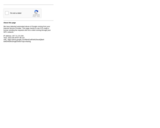
This is a presentation on Non verbal communication
1-What is communication?
2. What is Verbal and Non-verbal Communication?
3. Non-verbal Communication examples
4. Your body language may shape who you are
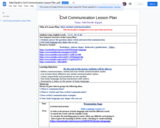
1-Students answer the questions about verbal and nonverbal communication.
2-Our body language may shape who we are.
By the end of this lesson, students will be able to:
• Define communication, verbal and non-verbal communication styles
• List at least three different non-verbal communication styles.
• Listen respectfully and positively to one another
• Use body language during interactions with others.
• Summarize a video on the power of body language.

Civil Communication Lesson Plan Organizer
Name: Adel Dardir
Lesson Plan in weeks

El objeto de aprendizaje Quizizz va dirigido a los estudiantes que cursan el primer grado de educación primaria que se encuentran en una edad entre 6 y 7 años de edad. Basado en el conteo y serie de diez en diez del tema de las decenas..
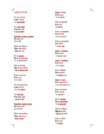
This resource will help you to pronounce correctly the sentences that are in the English language and to memorize the adjectives that are in red.

This resource will help you to pronounce correctly the sentences that are in the English language and to memorize the adjectives that are in red.
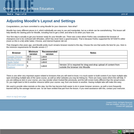
Adjusting Moodle's Layout and Settings
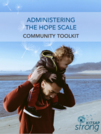
This resource provides schools and community organizations with a guide to administering the hope scale for children or adults. The resource provides background information about the Science of Hope, a decision chart on how to use the toolkit, step by step instructions on how to administer and score the hope scale. The toolkit PDF is informational, but the scoring template companion resource is interactive and includes formulas for the user to track data. The original toolkit content was developed for Kitsap Strong by Maya A. McKenzie, MPH, CPH.

Presento una lección sobre Estructura Organizacional, basada en los recursos humanos, con una actividad para complementar el contenido.

Tutorial for all schools in state of UT, for registering and enrolling students in the Statewide Online Education program.

Tutorial shared statewide for schools to know how to manage and setup students in the Statewide Online Education Program (SOEP) for state testing.
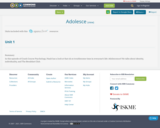
In this episode of Crash Course Psychology, Hank has a look at that oh so troublesome time in everyone's life: Adolescence! He talks about identity, individuality, and The Breakfast Club.
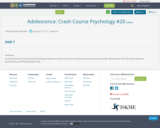
In this episode of Crash Course Psychology, Hank has a look at that oh so troublesome time in everyone's life: Adolescence! He talks about identity, individuality, and The Breakfast Club.
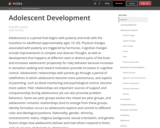
Reading with the learning objectives: 1) Describe major features of physical, cognitive, and social development during adolescence. 2) Understand why adolescence is a period of heightened risk taking.
3) Be able to explain sources of diversity in adolescent development.
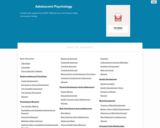
Textbook for Adolescent Psychology course
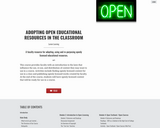
VCCS's "Pathways" Course provides faculty with an introduction to the laws that influence the use, re-use, and distribution of content they may want to use in a course. Activities include finding openly licensed content for use in a class and publishing openly licensed works created by faculty. At the end of the course, students will have openly licensed content that will be ready for use in a course.
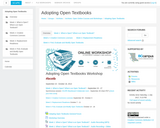
There are many layers when thinking about Open and Open Textbooks. In this first week of the workshop, we'll begin by peeling those layers back, starting with what Open actually means in the context of education. We'll then move on to looking at what an Open Textbook is. We've provided you with some resources to check out, and we ask that you post in the forum to talk to other participants about your experiences with openness.
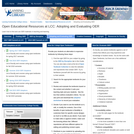
As faculty, you assess textbooks against a set of criteria that reflects your long experience and knowledge of student needs. You do the same with Open Textbooks, but there are a few additional considerations.